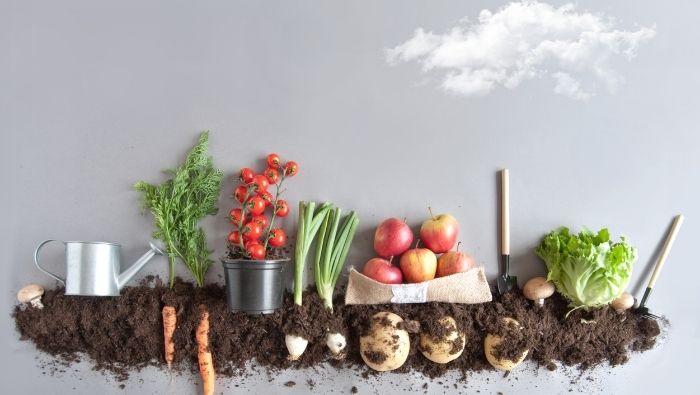Start a Money-Saving Lasagna Garden in 5 Simple Steps
by Amber B.

Lasagna gardening is a method of gardening that requires less labor and less time than others types of gardening. Take these five simple steps to start saving with your own lasagna garden.
Fall is an unusual time to start a garden, but it’s a great time to start a lasagna garden. Fall is the best time to gather all the needed materials. The soil is rich and moist and earthworms abound.
By growing your own food with a lasagna garden, you can save a lot of money. Plus, lasagna gardening is a wonderful way to garden that saves your back and your time because it is an unconventional method of gardening.
What Is a Lasagna Garden?
A lasagna garden is a no dig, no till, no weeding, no watering, and no fertilizing garden. It’s an ingenious layered compost technique that was started years ago by Patricia Lanza.
The name is unusual, but the optimal technique mimics the forest floor with its moist soil, which is the perfect environment for growing seeds.
August is a hot month in the United States. But, please don’t let that stop you from planting a fall lasagna garden. There is still plenty of time to have fresh, homegrown produce this fall.
Most crops are started from seed in May, June, and July. In August, it is best to buy established plant starts from your local nursery or garden supply store if you haven’t sowed your seeds yet.
Sign Up for Savings
Subscribe to get money-saving content by email that can help you stretch your dollars further.
Twice each week, you'll receive articles and tips that can help you free up and keep more of your hard-earned money, even on the tightest of budgets.
We respect your privacy. Unsubscribe at any time.
Here’s how it works and what supplies you need to get started:
Step 1. Choose Your Location and Cover
Decide where you want your garden. Start small, and then work up to a larger space as you see success each growing season.
Choose a sunny site and pre-soak the ground with water. Mark off an area 5′ x 5′ for a kitchen garden or 12′ x 12′ for a larger organic garden. Cover with three thick layers of wet newspaper or overlapping wet brown corrugated cardboard. This layer gets rid of grass and weeds and encourages earthworms to naturally till the earth underneath.
Step 2. Alternate Layers of Browns and Greens
Build the garden bed up 18 to 24 inches with alternating layers of brown and green organic materials. This is called “sheet composting.”
Brown organic materials include leaves, shredded newspaper or junk mail, wood chips, leaves, pine needles, and peat moss.
Green organic materials include vegetable scraps, grass clippings, coffee grounds, tea leaves and tea bags, egg shells, animal manure from chickens, rabbits or horses, and trimmings from the garden.
The brown layers should be about twice as deep as your green layers. The layers will “cook down” (compost) in only a few weeks and your garden will be ready to plant.
Step 3. Plant Your Seeds or Plants
Plant your seeds when last “frost date” has passed or plant your plant starts if you are getting a late fall start.
Top your lasagna garden bed with a few inches of soil/compost mix or wood chips (you can get these delivered free by calling your local tree trimmers) or place plants directly in soil.
After you plant your seeds or plants, you should water daily. (See Reduce Your Water Bill with Rain Barrels.)
Thin out the plants as they sprout up.
Step 4. Add More Mulch
In spring or summer, you may need to add peat moss or top soil. Then you can plant your garden right away.
In fall, layer as many greens and browns as you can with layers of peat or topsoil mixed in. Put three or four inches of topsoil on the top layer and plant in that. The garden will flatten as the layers underneath decompose.
Lasagna layers will compost easily and earthworms will cultivate and enrich the bed with nutrients.
If starting your garden in spring, early in the season (March-April), you will need to cover your garden with black plastic and let it sit for six weeks or more in the sunshine. Place small holes in the cover to allow rain water to soak the garden.
Step 5. Mulch for a Bountiful Harvest
Lasagna gardens can be made year-round. Fall is easiest with plenty of fallen leaves and other browns available. But, there is no right time of year to start one.
Prepare your soil now by layering the greens and browns. Add new layers of mulch each fall to sustain the garden’s fertility. The soil will become so rich, moist, and crumbly that you will grow an abundance of fruits and vegetables.
If you sow your lasagna garden now, you will soon be reaping a bountiful harvest and saving money, too.
Reviewed August 2023
Wouldn't you like to be a Stretcher too?
Subscribe to get our money-saving content twice per week by email and start living better for less.
We respect your privacy. Unsubscribe at any time.
Popular Articles
On After50Finances.com
- 9 Things You Need to Do Before You Retire
- You Didn’t Save Enough for Retirement and You’re 55+
- When Empty Nesters Reorganize and Declutter Their Home
- Reinventing Your Career in Your 50s or 60s
- What Mature Homeowners Should Know about Reverse Mortgages
- 2 Reasons to Collect Social Security Benefits As Soon As Possible

